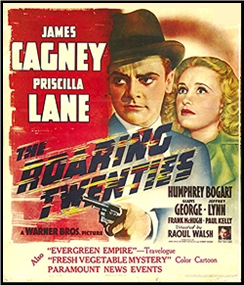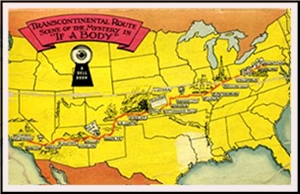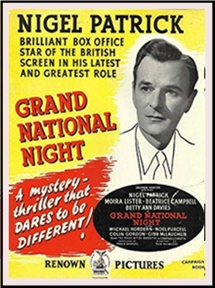July 2021
Monthly Archive
Tue 6 Jul 2021
REVIEWED BY DAN STUMPF:
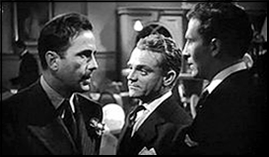
THE ROARING TWENTIES. Warner Brothers, 1939. James Cagney, Humphrey Bogart, Priscilla Lane, Gladys George, Jeffrey Lynn, Frank McHugh, Paul Kelly, Joe Sawyer, and Abner Biberman. Written by Jerry Wald, Richard Macaulay, Robert Rossen, Mark Hellinger, Earl Baldwin, Frank Donoghue, and John Wexley. Directed by Raoul Walsh.
Not so much a roar as a whimper. Warners obviously lavished a lot of care on this one (Just look at all those writers.) and the result was a lot of tedium.
Note that The Roaring Twenties was made in 1939. Everyone who worked on it, and most of the audience, would have remembered the era in a glow of youthful reminiscence, and the film became less a gangster picture than an exercise in nostalgia. So in place of fast-moving action, we get lengthy and rather pedestrian musical productions of the golden oldies of yesteryear.
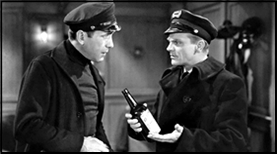
The story (WARNING!) starts with three doughboys (Cagney, Bogart & Lynn) who meet in the trenches of The Great War and strike up a tentative friendship. Back at home, Lynn becomes a lawyer, and Cagney a bootlegger who runs an honest racket, while Bogart tends toward the seamier side of law-breaking. Cagney takes a shine to young songstress Priscilla Lane, and invests in a nightclub to showcase her talents, but she falls for Lynn, and when they run off and get married, Jimmy takes to drink.
Come the Great Depression — seems like everything was “the Great†back then — Cagney loses everything and ends up a lowly cab driver, whenever he’s sober enough to drive. Chantoosie Gladys George has stuck with him through all this, with patience that outlasted mine by at least a half hour of running time, but he still burns his torch for Priscilla.
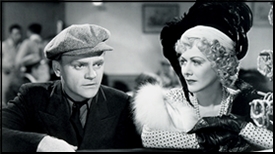
If all this seems a bit staid, that’s because it is. And as I say, it’s not helped any at all by musical interpolations that stop the story quite dead in its proverbial tracks. Compare this with Edward G. Robinson’s similar arc in The Hatchet Man, a fast-paced half-hour shorter, and you’ll see what I mean.
But then there’s the ending.
If you’ve never seen The Roaring Twenties, I won’t spoil it for you. Suffice it to say that Lynn and Bogart end up on opposite sides, and when Bogie gets menacing, Ms Lane turns to Cagney for help. The scene where he confronts Bogart is perfectly choreographed and effectively played: seedy cabbie vs big-shot gangster, with Jimmy at first humble, and Bogart dismissive.
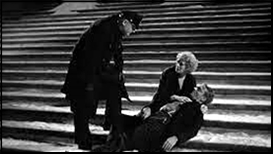
The knowing, defeated look in Cagney’s eyes when Bogart says, “It’s cold out, Eddie. I think I’ll have the boys give you a ride home.†Is almost worth sitting through the preceding ninety minutes. And Bogie’s cowardice when things go bad is just as convincing. The burst of action that follows is beautifully done by Raoul Walsh, a master stylist whose elegance was never fully appreciated.
I just wish the ending had come a bit earlier in the film. As it is, it makes the movie memorable. Watch it, but keep a finger poised on the Fast Forward button.
Mon 5 Jul 2021
Posted by Steve under
Reviews[3] Comments
REVIEWED BY BARRY GARDNER:
DOROTHY PORTER – The Monkey’s Mask. Jill Fitzpatrick #1. Hyland House, Australia, paperback, 1994. Arcade, US, hardcover, 1995. Serpent’s Tail, UK, paperback, 1997. Picador, Australia, paperback, 2000. Film: Strand, 2000, with Susie Porter as Jill Fitzpatrick.

I note this offering from a publisher new to me by an author likewise because it is surely the oddest “mystery” I’m likely to see this year, and maybe any other: an Australian lesbian PI novel written completely in verse. Trust me. If I’m lyin’ I’m dyin’. Porter has written several books, and this [the Arcade edition] is not a vanity press.
The book is blurbed as “an erotic murder mystery,” and I believe that’s a fairly apt description of the story underneath the verse. Details I’m not going to give you, because when someone tells you a dog sang, you don’t ask in what key.
And if you’re expecting any critical insights you’re out of luck there too, because a) I didn’t read it thoroughly or closely, and b) I’m not qualified to evaluate poetry. The verse is free — it doesn’t rhyme, anyway — and some of it struck me as pretty good; this, though, from someone who thinks Swinburne’s “Garden of Prosperpine” is about as good as it gets. What else can I say?
— Reprinted from Ah Sweet Mysteries #21, August-September 1995
Bibliographic Notes: This is the only entry for the author in Al Hubin’s Bibliography of Crime Fiction IV, but note that that book stops with the year 2000. It was the winner of the National Book Council Banjo Award (Australia’s equivalent to the Pulitzer Prize).
Sat 3 Jul 2021
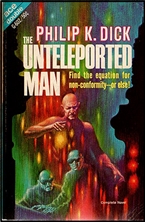
PHILIP K. DICK – The Unteleported Man. Ace Double G-602, paperback original, 1966. Cover art by Kelly Freas. First published as a novella in Fantastic Stories, December 1964. Expanded to novel length form under the same title by Berkley, paperback, 1983. First full edition reprinted in the US as Lies, Inc., by Vintage, trade paperback, 2004 (previously by Gollancz, UK, hardcover, 1984, but with two missing manuscript pages of the Berkley edition replaced by ones written by John Sladek).
The gateway to the colony at Whale’s Mouth in the Fermalhaut system is controlled by Trails of Hoffmn, who developed a teleportation system which put the ordinary spaceship line of Rachmael ben Applebaum near bankruptcy. The only drawback to emigration is the fact that the trip is (said to be) one-way, but Rachamel with the help of an inter-planetary police agency is determined to find out the true story while proving at the same time that spacecraft could have successfully made the 24-lightyear journey.
With the help of the suspect UN, the plan for the conquest of Earth – for of course it is one – is broken up. The story is enhanced considerably by the inclusion of Dick’s usual small details of the world of the future, while the characters move through a fairly ordinary plot.
Rating: ***
–September 1967
Fri 2 Jul 2021
Posted by Steve under
Reviews[7] Comments
GEORGE WORTHING YATES – If a Body. Hazlitt G. B. Woar #3. Morrow, hardcover, 1941. Triangle, hardcover reprint, 1942. Dell 159, paperback, mapback edition, 1947.
Someone reading this may come up with another example – and if so, it would be most welcome – but at the moment I think the murder investigation in this book could easily be unique: it takes place during a cross-country drive clear across the US, from a dinky tourist camp in eastern Ohio to some cabins for rent in Palmyra Hot Springs, a tiny town in the desert within shouting distance of Los Angeles, California.
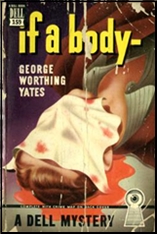
Of the 15 travelers, couples and families, who stopped for the first night in a rainstorm, only 14 leave. The death of one of them the authorities rule an accident, but a secret pact between some of them indicates that not only did they know that something was fishy about the death, but they’d also rather hush up about their suspicions so their travel plans would not be delayed.
But what this somehow means is that they end up taking the same route, their paths constantly crossing and overlapping each others. Two of them are husband and wife: Hazitt Woar and his new wife Kathern. They are on their honeymoon. His past includes a stint as a British detective, but in the previous book he ended up on the wrong side of the law in the US, and they are traveling under fictitious names and doing their best to avoid wanted posters as they go.
But Woar’s instincts as a detective cannot be denied, and to his new wife’s extreme frustration and displeasure, he finds he cannot deny his true calling. (At the end of the book, she gives in and allows him to start a new life in San Francisco as a private detective. Unfortunately this was the last of Woar’s three recorded adventures.)
This book took me a long time to read. An investigation conducted under such stretched out circumstances meant that the long middle section was continuously bogged down, especially while Woar is trying to keep his identity a secret at the same time he’s trying to solve a murder which may not be a murder at all.
While not deeply depicted, the characters are interesting, though, and individual people. And there are reasons their paths keep coming together every evening, which is due to very clever writing on Yates’s part. The ending is quite chaotic, though, and if I’m reading it right, the killer’s identity is revealed several pages before Woar explains all.
If you decide to read this anyway, after reading these observations and comments of mine, do it for fun, which it is. The details (and considerable pitfalls) of driving cross-country in the early 1940s are worth the price of admission in themselves.
The Hazlitt G. B. Woar series –
The Body That Came by Post. Morrow 1937.
The Body That Wasn’t Uncle. Morrow 1939.
If a Body. Morrow 1941.
Fri 2 Jul 2021
REVIEWED BY DAVID FRIEND:
GRAND NATIONAL NIGHT. Renown Pictures, UK, 1953; Allied Artists, US, 1955, as Wicked Wife. Nigel Patrick, Moira Lister, Beatrice Campbell, Betty Ann Davies, Michael Hordern, Noel Purcell, Leslie Mitchell. Director: Bob McNaught.
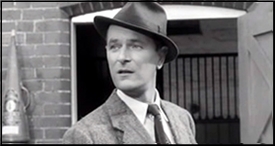
There are certain sub-genres of the crime drama which I will diligently seek out. Heist films, prison escape movies and the murder story in which we see who did it and how. 1920s crime fiction writer R. Austin Freeman invented the form and called it the ‘inverted detective story’. Columbo, of course, is the most famous example of this format on television while, in film, we have Hitchcock’s Dial M for Murder. They’re not so much whodunits as will-he-get-away-with-its? and are often headily suspenseful.
This thriller from Nettlefold Studios is slightly different. Racehorse trainer Gerald Coates (played by the always excellent Nigel Patrick) doesn’t intend to kill his drunken, mean-spirited wife Babs (Moira Lister). As an accident, therefore, there is no careful preparation and cool-headed problem-solving of the kind Ray Milland or Jack Cassidy had to deal with.
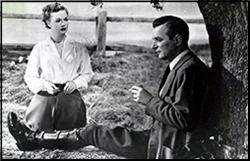
In truth, this decision makes the story less dramatic, but it also makes for an interesting change of pace, and ensures the protagonist has our sympathy. It could even be argued that he is the true victim of the piece as the viewers will surely wish they could kill Babs themselves.
The film was previously a radio serial on the BBC and, originally, a stage play by Dorothy and Campbell Christie. Its stage-bound origins are certainly obvious, as most of the action takes place in one large room at the Coates’ country estate. Indeed, many such stories, in my experience, do originate on stage. (There seems to be something about watching people die at a very close distance that engages theatre audiences like little else.)

In Grand National Night there are a few scattered instances in which we go beyond those walls – we visit Aintree racecourse, for instance, there’s an all-too-brief moment when Coates tries to evade the police on horseback, and a dreamily atmospheric flashback near the end.
The flashback, in particular, is required as, for most of the film, we are not sure just what has become of the dead wife. Indeed, it appears for a time as though she is still alive, as that is initially what Coates leads everyone to believe. Things do not seem any clearer when Babs is revealed to have died in nearby Liverpool. Coates tries to keep a diligent detective – played by the legendary Sir Michael Hordern – from discovering that Babs had, in fact, returned to the house before her death.
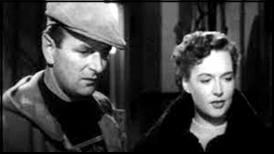
It is a shame that Nigel Patrick didn’t get more starring roles as he was clearly a very dependable actor. He was often cast as suave gentlemen, but I also caught him as a comically hyperactive spiv in 1948’s tonally inconsistent Noose (avoid it).
Also magnificent was Colin Gordon, a regular face on film and later television, who appears here in an unexpectedly key role. A neat bit of business, involving the two, wraps everything up neatly, making Grand National Night a pleasant and undemanding B-film.
Rating: ***
Thu 1 Jul 2021
FIRST YOU READ, THEN YOU WRITE
by Francis M. Nevins
There’s a general rule to which the most conspicuous exception in our genre is Agatha Christie: an author’s work dies with the author. Certainly Aaron Marc Stein’s has. Over a period of almost half a century he wrote a total of 114 novels, all but three of them whodunits, and at the peak of his career he was praised by Anthony Boucher of the New York Times Book Review as the most reliable professional detective novelist in America.
Try to find any of his books now. I began reading Aaron in my teens and got to meet him when he was in his early seventies. We remained friends for the rest of his life. Isn’t it time that I try to resurrect him?
He was the consummate New Yorker, born there on 15 November 1906, and for his college education went no farther than Princeton University, across the Hudson in New Jersey, from which he graduated in 1927, summa cum laude and Phi Beta Kappa. His first publisher was Covici Friede and his first novels, SPIRALS (1930) and HER BODY SPEAKS (1931), were of the avant-garde type and saw print thanks to endorsements from Theodore Dreiser.
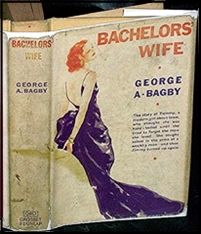
He then adopted the pseudonym of George Bagby for a long-forgotten romance novel, BACHELOR’S WIFE (1932). By this time he’d become interested in mystery fiction and, still using the Bagby byline, began writing what turned out to be a 48-book series of whodunits featuring Inspector Schmidt, a Manhattan police detective who is characterized mainly by taking off his shoes whenever possible, to ease the sore feet he developed in his early years as a beat cop.
The first three Schmidts were published by Covici Friede, with either Aaron or his editor opting to use Bagby as both the byline on the novels and the Watson figure. Bagby the character is not a cop but a professional writer commissioned to turn Schmidt’s cases into fiction. He calls himself Schmidty’s ghost writer but, since he not the Inspector is presented as the author, it’s more accurate to describe him as Schmidty’s chronicler, just as S.S. Van Dine, still a name to reckon with in the first half of the 1930s, was the chronicler of his detective hero, although Bagby is much more vivid than his unheard and invisible counterpart in the Philo Vance novels.
***
The fourth Schmidt, which is the earliest I have on my shelves, was the first of dozens of Aaron’s novels published over the next near half-century by Doubleday Crime Club. With the income from his early books rather paltry, he prudently kept the day job he’d held since shortly after graduating from Princeton, as a reporter for the New York Evening Post.
Eventually he became the paper’s radio critic, learned a huge amount about the inner workings of a broadcasting system, and put his knowledge to use in MURDER ON THE NOSE (1938). Schmidty and Bagby are implausibly first on the scene when the report comes in of what might almost be a John Dickson Carr impossible-crime situation: At the end of his signature tune “I Telegraph My Love to You,†and simultaneous with the sound of a clashing cymbal from the small orchestra backing him up, radio crooner Roddy James has been shot to death by an invisible assassin with an invisible gun in a broadcast studio full of people who saw nothing and heard nothing.
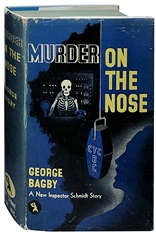
It soon develops that everyone on the scene — the musicians, the announcer, the sound control engineer, the sponsor — had opportunity to commit the murder, but no one seems to have a motive, and the only real mystery besides the obvious one of how-was-it-done concerns why the program’s sponsor, a manufacturer of toothache remedies, insisted on James as the program’s singer when he was unpopular, technically inept, and did nothing to promote the sponsor’s product.
Eventually there’s a second murder, a poisoning in a jazz club, and then a third, which bears a cousinly resemblance to the first, the victim this time being shut inside the broadcast system’s transmitter and electrocuted. With Schmidt we learn a great deal about the inner workings of 1930s radio before the solution, which is perhaps a bit too technical but indicates that Aaron must have done a prodigious amount of research into the nuts and bolts of broadcasting.
There are far too many said substitutes, the most overused of the lot being “murmured,†and a few incidental details, like the group of female gospel singers from Harlem who keep turning up at murders, are treated in a manner that might offend some 21st-century political correctness freaks. But I must say I enjoyed the book and am delighted to have had Aaron sign my copy more than forty years ago.
***
Before his next novel appeared, Aaron started working as a staff writer on Time magazine but he waited a few years to make use of that background. For the sixth Schmidt, THE CORPSE WITH THE PURPLE THIGHS (1939), he tapped into memories of his tenth reunion at Princeton in 1937, which I can’t believe was as chaotic or liquor-soaked as its fictional counterpart.
Although neither the town of Princeton nor its university is mentioned specifically, Bagby tells us that he is of the class of 1927, which Aaron was too. Having traveled by train to the nameless town from whose nameless university he’d graduated ten years earlier, and wearing the pirate costume that is the uniform for the class of ‘27, George makes for the firehouse that is serving as headquarters for the alumni of his year. (Alumni is precisely the right word here since all the grads are men. Princeton didn’t go co-ed until the late 1960s.)
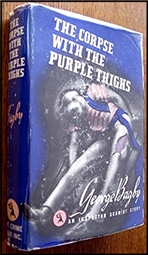
After some imbibing and a crap game he leaves the firehouse and, in the alley alongside the building, stumbles in the dark over what he first assumes is a drunk sleeping it off but quickly discovers is a corpse. He calls the local police, then returns to the alley with a fellow member of the class of ‘27 who’s a doctor. Voila! No corpse.
The Inspector drives down, arriving late that night, and tells Bagby that someone tried to run his car off the road after he’d stopped for directions at a local roadhouse, which happens to be run by a scar-faced mobster. Schmidty immediately takes over the local police department and soon gets to meet several of Bagby’s classmates including that doctor, a football hero known as Stinker, a congenital drunk known as Zipper, and a guy with a movie camera who’s determined to get every member of the class into his film.
Complications keep piling up during the long Friday night and, thanks to a total of three murders (the same total as in MURDER ON THE NOSE), nobody gets much sleep. Soon after the traditional Saturday morning parade of the various classes of grads, Schmidty pulls the proverbial rabbit out of the hat and, with total unfairness to the reader, collars the killer.
Bagby’s summary of everything that happened consumes several pages and leaves us wondering why the culprit made such a microscopically detailed confession. Frankly, I found this exploit rather uninvolving. Could Aaron have made a mistake taking Schmidty out of the big city? I didn’t try to count the number of lines of dialogue that the characters murmur but it must be huge.
***
We’re back in Manhattan with the next Schmidt novel, THE CORPSE WORE A WIG (1940). Like the previous books I’ve discussed here, this one features three murders, a very tight time frame, and countless lines of dialogue that their speakers murmur. (On one page that verb appears three times in ten short paragraphs.)
We also find what in later years was to become one of Aaron’s trademarks, a host of long long sentences worthy of Hegel or Faulkner. Here’s a typical example from early in Chapter One.
Just as my long career as Schmidty’s ghost has convinced me I cannot hope to rival his capacity for unraveling the tangled threads of a crime into its logical components and reassembling these into the inevitable web of the crime’s true texture, just so I do flatter myself that I have profited from this association with Schmidty at least to the extent of being able to confront a simple point of evidence with an open mind and read it for what it is worth.
The plot begins when a medical examiner doing a routine autopsy on another doctor, who seems to have died of natural causes, calls in Schmidty upon discovering that, as per the title, the cadaver was wearing a hairpiece — and beneath it a bullet hole which, on its way into the top of his skull, penetrated a perfectly fine head of hair identical to the wig.
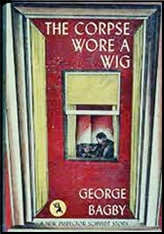
With Bagby in tow as usual, the Inspector visits the dead man’s office and residence, on the ground floor of an East 77th Street apartment building, and soon discovers that the doctor had only seven patients and wanted no more.
Questioning his nurse and her artist boyfriend reveals that the doctor had taken up the hobby of etching, and that a great deal of the cyanide he’d been using in his hobby is missing. During the Q&A two visitors come knocking, a former criminal turned theatrical wigmaker and a clearly but subtly gay hairdresser who prefers to be called a scalp specialist.
It soon develops that the doctor derived most of his income from operating a private medical service for injured criminals. Later that day the wigmaker and an employee of the hairdresser are found poisoned, giving us the requisite three bodies. Before midnight Schmidty has solved all three crimes, although Aaron denies us any chance to anticipate the solution and reveals the little-known fact that triggered Schmidt’s suspicions only in the last paragraph.
Nevertheless I sort of liked the book, mainly because of some interesting situations — would a woman try to create an alibi by tethering herself to a permanent-wave machine that burned her hair and scorched her scalp? — and the glimpses of offtrail environments like the wigmaking and hairdressing emporiums. But purely as a detective novel it’s nothing special.
***
The eighth in the series, RED IS FOR KILLING (1941), differs from earlier Bagby novels in several respects. There’s only one murder — supplemented by two near-fatal assaults, one of them on Bagby himself — the time span covers two whole days and nights, and Aaron seems to have cured himself of the Faulkner sentence syndrome and murmuritis.
He also made such use of his stint at Time magazine, which he portrayed (whether fairly or not I have no idea) as a zoo full of screwballs writing their journalism in a wacko parody of normal English, that he would surely have been fired if he hadn’t already resigned to become a professional novelist.
Schmidt and Bagby visit the offices of the upstart newsmagazine Tidings, on the top three floors of the same skyscraper that houses the Coast to Coast Broadcasting Network from MURDER ON THE NOSE, when the body of its newest employee, the sharp point of a letter spike buried in the back of his neck, is found in one room of the magazine’s offices, a special library devoted to the collapse of an automotive empire.
His aching feet encased in comfortable slippers, Schmidty comes to suspect that the more he learns about the dead man and why he was hired the more likely he’ll find the murderer, and starts questioning several of the Tidings brass — a can of mixed nuts of the first water — and a few outsiders including an obnoxious gossip columnist, a politically ambitious plutocrat and the widow of one of the men involved in that business collapse.
Readers are apt to figure out the late Harold Quimby’s real identity sooner than Schmidt does but have no chance of solving the murder puzzle ahead of the Inspector since Aaron as usual has no interest in playing fair. But his vivid if perhaps biased evocation of the newsmagazine environment, foreshadowing his explorations of various Manhattan milieus in later novels, helps make RED IS FOR KILLING one of his better early efforts.
***
Those efforts consist of nine Bagbys plus the first four whodunits published under his own name, which featured the archaeologist/amateur detective team of Tim Mulligan and Elsie Mae Hunt.
What put an end to his first period was Pearl Harbor. He joined the Office of War Information and later the Army, in which he served as a cryptographer. On his return to civilian life he went back to writing full-time and continued to do so until his death forty years later.
It was the novels he wrote in the late Forties and Fifties that led Anthony Boucher to call him the most reliable American practitioner of his genre. In later columns I hope to explore some of them.
« Previous Page




